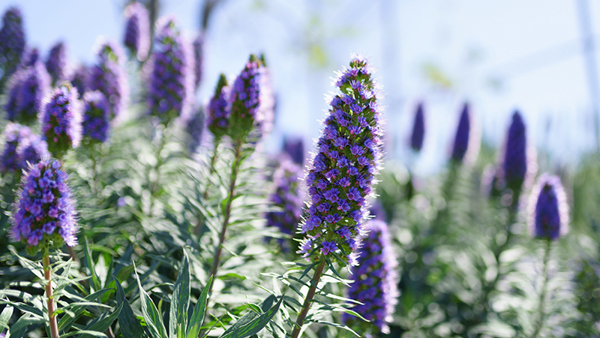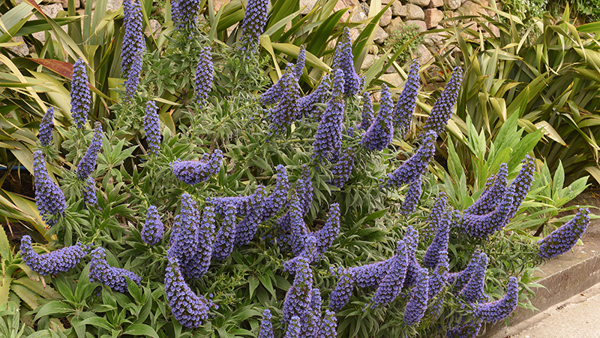Yates Account
Join now
Create a Yates account today!
Sign up to join the Yates Garden Club for monthly e-mails packed with seasonal inspiration, tips for success & exclusive promotions.
Plus if you’re a Garden Club member you can take part in the Yates Growing Community - a blog to share successes, get advice & win prizes in fun challenges along the way!

Forgot password
Enter the email address associated with your account, and we'll email you a new password.

Echium or commonly known as Pride of Madeira (Echium spp.) are hardy flowering perennial plants that are known for their cone like flower spikes that are renowned for their ability to attract bees to the garden. With their fast growing grey colour foliage and cone flowers available in an array of purple, pink to white colours, they produce an attractive plant to place along pathways, hard to plant areas or in cottage gardens.
How to grow Echium in a garden
- Choose a position in full sun or part shade with well drained soil.
- Enrich the soil with Yates Dynamic Lifter Organic Plant Food. If the soil is clay based, add gypsum and fork in well.
- Dig the planting hole twice as wide and to the same depth as the root-ball. Remove the plant from the container and gently tease the roots.
- Position in hole and backfill, gently firming down. Form a raised ring around the plant, creating a well so that water will go where it’s needed most. Water in well.
- Mulch with an organic mulch like woodchip or pea straw, keeping it away from the base of the plant.
- Water deeply, once or twice a week, depending on weather conditions.
- During the growing and flowering season feed with Yates Thrive Rose & Flower Granular Plant Food. TIP: for an added boost apply Yates Thrive Roses & Flowers Liquid Plant Food.


How to grow Echium in a pot
When choosing an Echium for a pot, look for a dwarf variety which are more suitable for pots.
- Choose a pot at least 300mm wide.
- Position in full sun or part shade.
- Fill pot with quality potting mix, such as Yates Premium Potting Mix.
- Remove the plant from the container and gently tease the roots.
- Position in hole and backfill, gently firming down.
- Water in well.
- Water deeply, once or twice a week, depending on weather conditions.
- During the growing and flowering season, apply Yates Thrive Roses & Flowers Liquid Plant Food. Throughout the year apply Yates Thrive Fish Blood & Bone Plant Food Concentrate.
Growing tips
-
Echiums dislike having wet feet and can suffer from root rot in soils that are poorly drained or if they are over watered.
- Remove spent flowers to promote further blooms.
- Lightly prune bushes after flowering ensuring only to cut into the soft wood.
- Great for border plantings and in areas where salty winds are prevalent.
- Perfect plant for attracting bees to the garden.
More Plants
Hellebores are the moody, gothic jewels of the winter garden. Learn how you can grow them in garden or in pots.
Gardenia
Gardenias have soft scented blooms in white or yellow. Depending on the variety, can be grown as a shrub, standard, hedge or ground cover.
Freesia
Freesias are a spring flowering bulb that produce scented blooms in a range of vibrant colours including pinks, white, yellow, mauve and red.
Flax
Flax (Phormium spp.) are highly versatile plants which can grow well in swampy or dry conditions. Great for large pots or en-masse in garden beds.
Yates Thrive Rose & Flower Granular Plant Food
Specially formulated to grow all types of flowers. With high potassium for large & abundant flowers, added calcium & iron for stronger flowers.
Yates Thrive Roses & Flowers Liquid Plant Food
Provides your flowers & roses with the balanced nutrients they require for healthy growth and flower production.
Yates Premium Potting Mix
A premium potting mix, ideal for all potted plants and shrubs, including ornamentals, fruit trees, vegies and herbs.
Yates Dynamic Lifter Organic Plant Food
Releases nutrients slowly, improves the structure and moisture retention of the soil and encourages earthworms and beneficial soil micro-organisms.
















Share
Share this article on social media